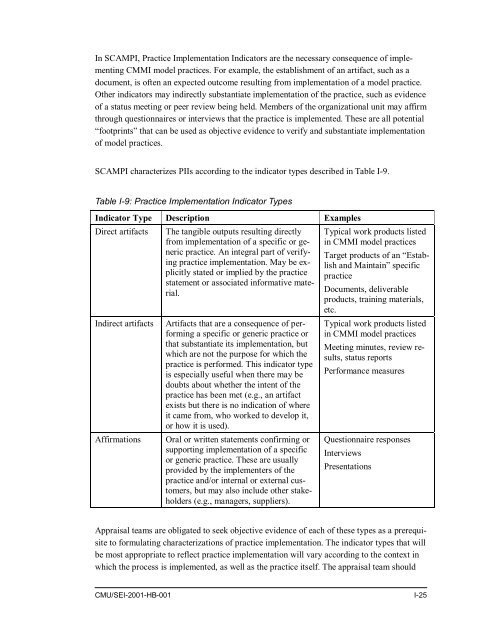Standard CMMI Appraisal Method for Process Improvement (SCAMPI)
Standard CMMI Appraisal Method for Process Improvement (SCAMPI)
Standard CMMI Appraisal Method for Process Improvement (SCAMPI)
You also want an ePaper? Increase the reach of your titles
YUMPU automatically turns print PDFs into web optimized ePapers that Google loves.
In <strong>SCAMPI</strong>, Practice Implementation Indicators are the necessary consequence of implementing<br />
<strong>CMMI</strong> model practices. For example, the establishment of an artifact, such as a<br />
document, is often an expected outcome resulting from implementation of a model practice.<br />
Other indicators may indirectly substantiate implementation of the practice, such as evidence<br />
of a status meeting or peer review being held. Members of the organizational unit may affirm<br />
through questionnaires or interviews that the practice is implemented. These are all potential<br />
“footprints” that can be used as objective evidence to verify and substantiate implementation<br />
of model practices.<br />
<strong>SCAMPI</strong> characterizes PIIs according to the indicator types described in Table I-9.<br />
Table I-9: Practice Implementation Indicator Types<br />
Indicator Type Description Examples<br />
Direct artifacts The tangible outputs resulting directly<br />
from implementation of a specific or generic<br />
practice. An integral part of verifying<br />
practice implementation. May be explicitly<br />
stated or implied by the practice<br />
statement or associated in<strong>for</strong>mative material.<br />
Indirect artifacts<br />
Affirmations<br />
Artifacts that are a consequence of per<strong>for</strong>ming<br />
a specific or generic practice or<br />
that substantiate its implementation, but<br />
which are not the purpose <strong>for</strong> which the<br />
practice is per<strong>for</strong>med. This indicator type<br />
is especially useful when there may be<br />
doubts about whether the intent of the<br />
practice has been met (e.g., an artifact<br />
exists but there is no indication of where<br />
it came from, who worked to develop it,<br />
or how it is used).<br />
Oral or written statements confirming or<br />
supporting implementation of a specific<br />
or generic practice. These are usually<br />
provided by the implementers of the<br />
practice and/or internal or external customers,<br />
but may also include other stakeholders<br />
(e.g., managers, suppliers).<br />
Typical work products listed<br />
in <strong>CMMI</strong> model practices<br />
Target products of an “Establish<br />
and Maintain” specific<br />
practice<br />
Documents, deliverable<br />
products, training materials,<br />
etc.<br />
Typical work products listed<br />
in <strong>CMMI</strong> model practices<br />
Meeting minutes, review results,<br />
status reports<br />
Per<strong>for</strong>mance measures<br />
Questionnaire responses<br />
Interviews<br />
Presentations<br />
<strong>Appraisal</strong> teams are obligated to seek objective evidence of each of these types as a prerequisite<br />
to <strong>for</strong>mulating characterizations of practice implementation. The indicator types that will<br />
be most appropriate to reflect practice implementation will vary according to the context in<br />
which the process is implemented, as well as the practice itself. The appraisal team should<br />
CMU/SEI-2001-HB-001 I-25
















